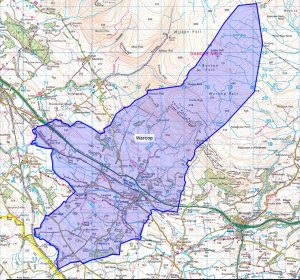The Parish of Warcop
The Parish of Warcop covers roughly an extended NE-SW diamond shape in the upper Eden valley. Its most NE point is Mickle Fell on the MOD ranges and encompasses Burton Fell, Long Fell and Warcop Fell and the boundary crosses the A66 and loops around the main habitation areas of the Parish.
The Parish covers an area of ca. 11,500 acres (4660 ha) in total, around 50% being uninhabited MOD land of the Warcop Ranges. The Parish is predominantly rural covering many farmsteads and the villages of Warcop and Sandford as well as the hamlets of Bleatarn and Coupland Beck (part). It encompasses roughly 220 properties with around 570 inhabitants (2021 Census).
The Parish map can be viewed electronically at https://maps.walkingclub.org.uk/admin/cumbria/eden/warcop-parish.html
Origins
The name Warcop means ‘hill with a cairn’, and was spelt Warthecopp and otherwise in the 13th century and earlier. It is a compound word that combines viking age Old Norse varða (cairn, a pile of stones) and the Old English copp (a summit or hill top). The lords of the manor of Warthecopp / Warcop over time changed their surname from Warthecopp to Warcop.
A little bit of History
The manor of Warcop was held by the Warcop family from early 13th century but had passed to Ralph Neville, Earl of Westmorland, by 1422. It was said to have been regained by the Warcop family in 1554; then sold to Thomas Braithwaite of Ambleside in 1590, with whose descendants it remained until 1740. The manor was then held by Preston and Wild families until 1957.
The manor of Sandford was held by the Sandford family from 12th century to early 15th century when it passed by co-heirs to Bardsey and Warcop families; tenants enfranchised the manor in 1592 and purchased manorial rights in 1690.
The manor of Burton (former village located on the Warcop ranges) was held by the Hilton family by 13th century, descending in that family until marriage of Mary Hilton to Thomas Wybergh of Clifton 1713; it then descended through the Wybergh family to 20th century when manorial rights were bought by Ministry of Defence and the Manor House etc. demolished.
Bleatarn was a grange of Byland Abbey (Yorks.), passing after Dissolution successively to families of Bellasis, Salvin, Fothergill and Musgrave.

